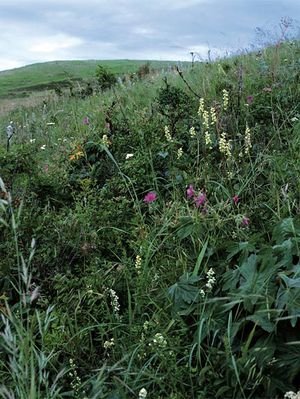State crews spray herbicide on Palouse Prairie native plants
NATIVE SPECIES -- One would think that state employee applicators would be educated about native plants before they are turned loose with industrial quantities of herbicide.
What's interesting is that the spraying of native Palouse Prairie plants occurred in the backyard of where these Whitman County employees live. The topic of the ongoing conservation effort to protect the last remnants of native Palouse Prairie had to come up in their presence somewhere, sometime.
Have some pride in your job and neighborhood, men.
Here's the story from the Moscow-Pullman Daily News via AP:
Mismanagement of weeds along the Pullman-Moscow highway in Whitman County may be killing what little remains of the Palouse Prairie.
Richard Old, who has a doctorate in plant science and does plant identification research for both the University of Idaho and Washington State University, noticed this past week that someone had sprayed herbicide on broadleaf plants native to the Palouse Prairie and left the real weeds to prosper along the highway right of way.
“Someone drove all over this site to spray weeds and they didn’t even spray weeds,” Old said Tuesday as he viewed the damage. “I’m all about weed control, but it has to be done appropriately, and it’s just not.”
Walking through remnants of the prairie along the Pullman-Moscow corridor, Old identified more than a half-dozen native species that are now wilting and turning yellow or that had been run over during the spraying process.
He also identified Hesperis matronalis, or damsel rocket, which he said was left unsprayed because of its eye-appealing bright purple color and the misconception that the weed is a flower.
“Here’s poison hemlock, the plant that killed Socrates. Did they spray that? No,” Old said, making his way through another site of dying plants. “This was all Palouse Prairie. We executed one of the most diverse ecosystems on the planet. These guys go in and kill it with no rationale except ignorance.”
Old said he suspected it was the Washington State Department of Transportation that was behind the spraying.
He suspected right.
Ray Willard, a landscape architect who oversees herbicide application throughout the state for WSDOT, said his crews sprayed the site during the first week of May. Willard’s fellow state weed employees in the regional office ventured to the site Thursday to examine it with Old and determine who was at fault for destroying the remnant of the ecosystem.
Old and the WSDOT officials showed up at a site along the highway where hundreds of Lomatium dissectum, or fern-leaved lomatium, plants lay on the ground or drooped and curled toward it.
Tom Reibold, a WSDOT officer from Colfax, said he sprayed the plants because he was unaware the native plants weren’t weeds.
“We’re guilty – we sprayed them,” Reibold said, adding he’d sprayed the same plants in years past but never heard that it shouldn’t be happening.
“We screwed up on this,” Reibold said. “Hopefully they come back.”
Old said he hopes they come back too, but couldn’t say to what extent they would.
As for the violet flower-looking weeds, Reibold said those were sprayed, but the herbicide didn’t fare well in killing the weeds.
Willard made it clear it’s not the state’s goal to destroy the native environment.
“We are working to avoid misapplications,” he said. “We are trying to reestablish native plant communities where we can so the roadside is self-maintaining.”
Old said the death of the natives will only result in more open soil for more weeds to flourish.
“What they did will increase the chance of weeds,” he said. “This is your tax dollars at work.”
Reibold took pictures of the site to send to Willard, and he proposed making it a no-spray zone.
“It’s not our goal to ruin the world,” he said. “Obviously, we don’t know all the weeds.”
Willard said the state trains employees on what weeds to target.
“If this is our mistake we will use it as a learning tool and add it to our maps and make sure it isn’t mismanaged in the future,” Willard said.
Old, a former teacher for WSDOT on weed spraying, said a lack of education about what’s a weed and what’s not is the core of the problem.
“There’s an old saying – ignorance of the law is no excuse,” he said.
Old said the piece of the Palouse Prairie had been protected from farming for years by the right of way from the highway and the Bill Chipman Palouse Trail. He said the native plants remain throughout the Palouse only on rocky portions of hillsides, as the land is too shallow to plow.
He said less than 1 percent of what was Palouse Prairie remains today.
“What’s left of the Palouse Prairie are the anomalies, not big enough to make a wheat field,” Old said. “This site shows the diversity of the Palouse. This is what the other 99 percent looked like.”

